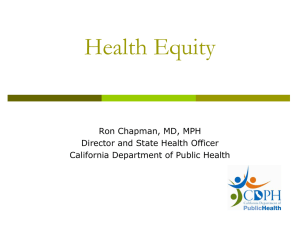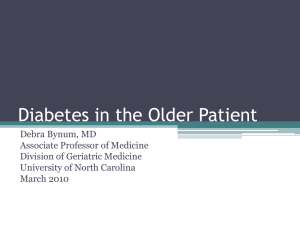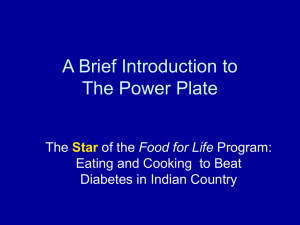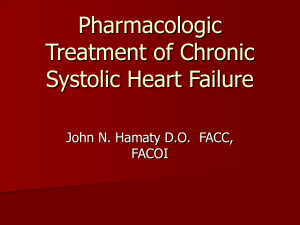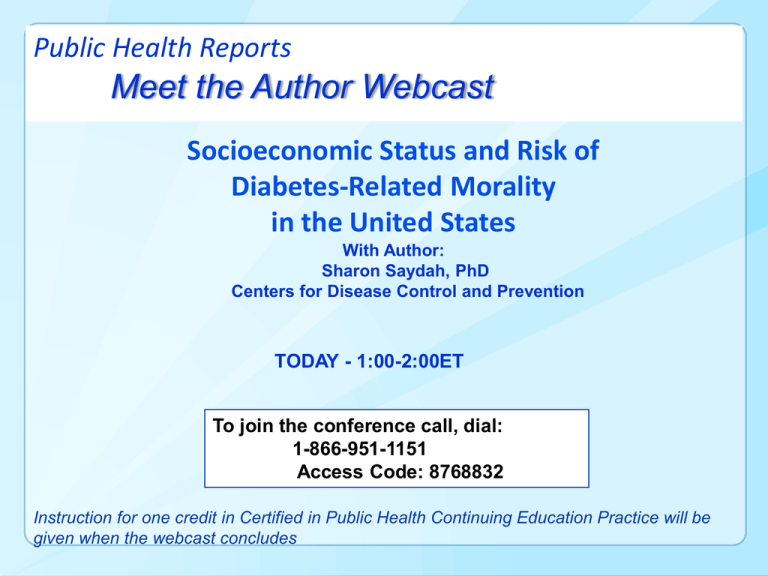
Public Health Reports
Meet the Author Webcast
Socioeconomic Status and Risk of
Diabetes-Related Morality
in the United States
With Author:
Sharon Saydah, PhD
Centers for Disease Control and Prevention
TODAY - 1:00-2:00ET
To join the conference call, dial:
1-866-951-1151
Access Code: 8768832
Instruction for one credit in Certified in Public Health Continuing Education Practice will be
given when the webcast concludes
Public Health Reports
Meet the Author Webcast
Socioeconomic Status and Risk of
Diabetes-Related Morality
in the United States
Sharon Saydah, PhD
Centers for Disease Control
and Prevention
May-June 2010, Volume 125-3
Socioeconomic Status and Risk of
Diabetes-Related Morality in the
United States
Sharon Saydah, PhD
Division of Diabetes Translation
Centers for Disease Control and Prevention
Disclaimer
The views and interpretations
presented in this paper are those of
the authors and do not necessarily
represent the official position of the
Centers for Disease Control and
Prevention.
Objectives
• Examine socioeconomic (SES)
differences in diabetes mortality in the
United States.
• Highlight the importance of SES in
assessing the social determinants of
diabetes mortality.
• Discuss the strengths and challenges
of using national data to examine SES
of diabetes.
Trends in diabetes-related mortality
in the United States
Saydah S. Eberhardt M. Chapter 12 “Diabetes and Mortality” in Diabetes Public Health: From Data to Policy,
In press, Figure 1.
Background
• Diabetes was the 7th leading cause of
death in the United States 2007.
• Diabetes mortality is a focus area of
Healthy People 2010.
– Goal to eliminate health disparities.
– Tracks diabetes-related mortality for
different education groups.
• Few prospective studies on
socioeconomic differences in
diabetes-related mortality.
Previous studies
• American Cancer Society cohorts
(1959 - 1972 and 1982 -1996)
– Inverse gradient for education and
diabetes mortality
– No information on race/ethnicity or
income
• National Longitudinal Mortality Study
(1979 -1989)
– Strong inverse relationship with income
and diabetes mortality
Methods: Data sources
• National Health Interview Survey
(NHIS)
– In-person survey
– Years included 1990 through 2000
• Linked mortality files
– National death index
– Follow-up through December 31, 2002
Methods: Analytic sample
• Inclusion criteria
– Aged 25 years and older at time of
interview
– Non-Hispanic white, non-Hispanic black,
and Hispanic
– Complete information on all variables of
interest
– Final sample size n = 527,426
Methods: Socioeconomic measures
• Education
–
–
–
–
< high school
High school graduate
Some college
College graduate or greater
• Income (Federal Poverty Level, [FPL])
–
–
–
–
< 1.00
1.00 - 1.99
2.00 - 3.99
4.00 +
• Approximately 18% of the sample had unknown income.
Imputed income used for these participants.
Methods: Covariates
• Sex
• Race/ethnicity
• Martial status
– Married
– Divorced/separated/widowed
– Never married
• Body mass index (BMI) kg/m2
– Based on self reported height and weight
– Underweight, normal, overweight, obese
and extremely obese
Methods: Outcome
• Deaths ascertained from time of
interview to December 31, 2002
• Diabetes-related mortality
– Includes deaths with diabetes indicated
as an underlying or contributing cause
• Number of diabetes deaths = 5,613
• Mean follow-up = 6.4 person years
Analysis
• Age adjusted diabetes mortality
• Proportional hazards models with age
as the time scale
• All analysis weighted to the U.S.
population and accounts for the NHIS
complex survey design
Analysis
• Calculated percentage explained by
the covariates in the model:
% explained =
(RH unadjusted – RH adjusted)
(RH unadjusted – 1)
Baseline characteristics aged 25 years and older in NHIS 19902000, United States
Overall
< High
school
High school
Some
college
College
degree
Age, yrs
48.4
56.2
45.4
45.2
48.9
Male, %*
48.0
47.3
45.6
46.7
53.2
NH white, %*
81.8
67.3
83.4
83.0
89.6
NH black, %*
11.2
16.3
11.3
11.4
6.9
Hispanic, %*
7.0
16.4
5.3
5.6
3.5
Married, %*
67.5
58.7
68.8
68.1
72.0
Divorced/widowed, %*
20.6
31.0
20.9
19.6
12.8
Never married, %*
12.0
10.3
10.4
12.4
15.2
2.3
2.9
2.2
2.1
2.2
Normal, %*
42.1
36.1
40.8
41.8
49.0
Overweight, %*
35.7
36.5
36.0
35.7
34.8
Obese, %*
13.2
16.0
13.8
13.3
9.8
6.7
8.4
7.2
7.2
4.2
Underweight, %*
Extremely obese, %*
* Statistically different across the Federal Poverty Level (FPL) groups based on 2 p < 0.001
Baseline characteristics aged 25 years and older in NHIS 19902000, United States
< 100% FPL
100-199% FPL
200-299% FPL
300-399% FPL
≥ 400% FPL
Age, yrs
48.9
51.4
48.6
46.6
47.3
Male, %*
37.5
44.3
48.2
49.8
52.2
NH white, %*
57.3
74.5
83.0
86.9
90.0
NH black, %*
26.3
15.0
10.5
8.3
6.4
Hispanic, %*
16.4
10.5
6.6
4.8
3.6
Married, %*
41.0
59.3
69.8
75.1
74.7
Divorced/widowed, %*
39.3
28.8
19.6
14.8
13.8
Never married, %*
19.7
11.9
10.6
10.1
11.5
Underweight, %*
3.6
2.8
2.3
2.1
1.8
Normal, %*
37.9
40.1
41.7
43.4
44.1
Overweight, %*
32.3
34.7
35.7
36.2
37.2
Obese, %*
15.6
14.3
13.7
12.4
11.9
Extremely obese, %*
10.6
8.2
6.7
5.9
5.1
* Statistically different across the Federal Poverty Level (FPL) groups based on 2 p < 0.001
Percentage of adults by education
and poverty level, NHIS 1990-2000
< 100% FPL
100-199%
FPL
200-299%
FPL
300-399%
FPL
≥ 400% FPL
< High
school *
48.8
34.0
17.9
10.3
5.2
High school
graduate *
32.1
39.9
41.3
36.1
26.2
Some
college *
14.0
18.4
25.1
27.4
26.8
College
graduate *
5.2
7.7
15.7
26.2
41.8
* Statistically different across the education groups based on 2 p < 0.001
FPL = Federal Poverty Level
Diabetes-related mortality by education
level
< HS
HS grad
Some college
College grad
250
200
150
100
50
0
Men
Women
Non-Hispanic Non-Hispanic
white
black
Age adjusted to the 2000 U.S. standard population
Rates per 100,000 person years
Hispanic
Diabetes-related mortality by Federal
Poverty Level (FPL)
< 100% FPL
100-199% FPL
300-399% FPL
400%+
200-299%FPL
250
200
150
100
50
0
Men
Women
Non-Hispanic Non-Hispanic
white
black
Age adjusted to the 2000 U.S. standard population
Rates per 100,000 person years
Hispanic
Risk of diabetes-related mortality by
education level
Education
level
Model 1: RH
(95% CI)
Model 2: RH
(95% CI)
Model 3: RH
(95% CI)
% explained
(model 3
compared to 1)
< HS
2.46
(2.15, 2.82)
2.27
(1.98, 2.61)
2.05
(1.78, 2.35)
28%
HS grad
1.60
(1.39, 1.83)
1.65
(1.44, 1.90)
1.57
(1.37, 1.80)
5%
Some college
1.48
(1.27, 1.74)
1.52
(1.30, 1.70)
1.46
(1.25, 1.71)
4%
College grad
1.00
(reference)
1.00
(reference)
1.00
(reference)
Relative hazards (RH) based on proportional hazards model with age as the time scale.
Model 1: adjusted for socioeconomic status indicator only
Model 2: model 1 additionally adjusted for demographic characteristics
Model 3: model 2 additionally adjusted for BMI
Risk of diabetes-related mortality by
education level
Education level
Model 3: RH
(95% CI)
Model 4: RH
(95% CI)
% explained
(model 4
compared to 3)
< HS
2.05
(1.78, 2.35)
1.55
(1.34, 1.80)
48%
HS grad
1.57
(1.37, 1.80)
1.32
(1.15, 1.53)
44%
Some college
1.46
(1.25, 1.71)
1.33
(1.13, 1.56)
28%
College grad
1.00 (reference)
1.00 (reference)
Relative hazards (RH) based on proportional hazards model with age as the time scale.
Model 3: adjusted for socioeconomic status indicator, demographics and BMI
Model 4: model 3 additionally adjusted for FPL
Risk of diabetes-related mortality by
Federal Poverty Level
Federal
Poverty
Level
% explained
(model 3
compared to 1)
Model 1: RH
(95% CI)
Model 2: RH
(95% CI)
Model 3: RH
(95% CI)
< 100%
2.94
(2.53, 3.42)
2.64
(2.25, 3.10)
2.41
(2.05, 2.84)
27%
100-199%
2.21
(1.92, 2.54)
2.11
(1.83, 2.43)
1.98
(1.71, 2.28)
19%
200-299%
1.81
(1.56, 2.10)
1.78
(1.53, 2.06)
1.70
(1.47, 1.97)
14%
300-399%
1.24
(1.05, 1.46)
1.23
(1.04, 1.45)
1.20
(1.02, 1.42)
17%
≥ 400%
1.00
(reference)
1.00
(reference)
1.00
(reference)
Relative hazards (RH) based on proportional hazards model with age as the time scale.
Model 1: Adjusted for socioeconomic status indicator only
Model 2: Model 1 additionally adjusted for demographic characteristics
Model 3: Model 2 additionally adjusted for BMI
Risk of diabetes-related mortality by
Federal Poverty Level
Federal
Poverty Level
Model 3: RH (95%
CI)
Model 4: RH
(95% CI)
% explained
(model 4
compared to 3)
< 100%
2.41
(2.05, 2.84)
2.07
(1.73, 2.46)
27%
100-199%
1.98
(1.71, 2.28)
1.73
(1.48, 2.02)
19%
200-299%
1.70
(1.47, 1.97)
1.55
(1.33, 1.81)
14%
300-399%
1.20
(1.02, 1.42)
1.14
(0.96, 1.35)
17%
≥ 400%
1.00
(reference)
1.00
(reference)
Relative hazards (RH) based on proportional hazards model with age as the time scale.
Model 3: adjusted for socioeconomic status indicator , demographics and BMI
Model 4: model 3 additionally adjusted for education levels
Discussion
• Socioeconomic gradient exists with
diabetes-related mortality
• Increased risk of mortality for all
income groups compared to the
highest income group
• Increased risk of morality for all
education groups compared to college
graduates
Limitations
• Possible underreporting of diabetes
morality on death certificates
– Not known whether underreporting differs
by socio-economic status in U.S.
– U.K.P.D.S. study found lower social class
more likely to have diabetes coded on
death certificate
• Education and income only measured
at baseline
Strengths
• Nationally representative
• Recent data
• Included more than one SES indicator
• Large sample allows examination of
both lower and upper ends of SES
Conclusions
• Reducing overall diabetes mortality
and disparities in diabetes mortality an
important goal for federal programs.
– Healthy People 2010
– National Diabetes Education Program
• Diabetes mortality research provides
guidance for primary, secondary
tertiary diabetes prevention efforts
Socioeconomic Status and Risk of
Diabetes-Related Morality
in the United States
Questions and Answers
Sharon Saydah, PhD
Centers for Disease Control
and Prevention
Public Health Reports
Meet the Author Webcast
http://www.publichealthreports.org
Next Webcast: December 7th, 1:00 ET
Tracking Parent's Concerns about Childhood Vaccines –
A Public Health Surveillance System
With:
Philip Smith, PhD
CDC, National Center for Immunization and Respiratory Disease
Edgar Marcuse, MD, MPH
Washington University School of Public Health
Certification in Public Health Continuing Education Practice, please go to:
http://www.shoppublichealth.org/
Link to the CE credits is on the left side of the page

